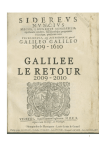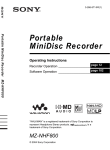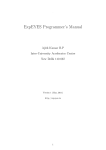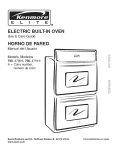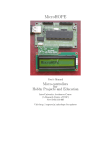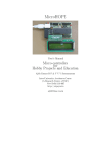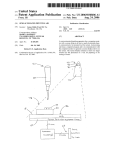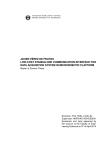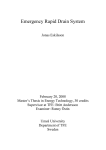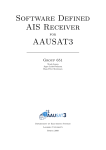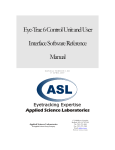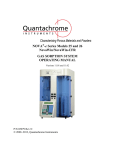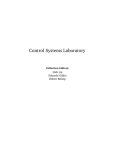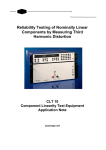Download expEYES Junior
Transcript
expEYES Junior User's Manual Experiments for Young Engineers and Scientists http://expeyes.in from PHOENIX Project Inter-University Accelerator Centre (A Research Centre of UGC) New Delhi 110 067 www.iuac.res.in Preface The PHOENIX (Physics with Home-made Equipment & Innovative Experiments) project was started in 2004 by Inter-University Accelerator Centre with the objective of improving the science education at Indian Universities. Development of low cost laboratory equipment and training teachers are the two major activities under this project. expEYES Junior is a modied version of expEYES released earlier. It is meant to be a tool for learning by exploration, suitable for high school classes and above. We have tried optimizing the design to be simple, exible, rugged and low cost. The low price makes it aordable to individuals and we hope to see students performing experiments outside the four walls of the laboratory, that closes when the bell rings. Hardware design is open and royalty-free. The software is released under GNU General Public License. The project has progressed due to the active participation and contributions from the user community and many other persons outside IUAC. We are thankful to S Venkataramanan and Prof. R Nagarajan for correcting this document by carrying out the experiments described independently. expEYES Junior user's manual is distributed under GNU Free Documentation License. Ajith Kumar B.P. V V V Satyanarayana Jimson Sacharias ([email protected]) http://expeyes.in Contents 1 Getting Started 1.1 Introduction . . . . . . . . . . . . . . . 1.2 The equipment . . . . . . . . . . . . . . 1.2.1 External connections . . . . . . . 1.2.2 Accessory Set . . . . . . . . . . . 1.3 Software Installation . . . . . . . . . . . 1.4 The main GUI program . . . . . . . . . 1.5 Basic measurements using expEYES . . 1.5.1 Generate & measure voltages . . 1.5.2 Observe voltage waveforms . . . 1.5.3 Measure frequency & Duty cycle 1.5.4 Accuracy and resolution . . . . . 1.6 Experiments . . . . . . . . . . . . . . . . 2 Electricity 2.1 2.2 2.3 2.4 2.5 2.6 2.7 2.8 2.9 2.10 2.11 2.12 2.13 2.14 2.15 2.16 2.17 2.18 2.19 2.20 2.21 2.22 2.23 Measuring Voltage . . . . . . . . . . . . Voltage, current & resistance . . . . . . Calibrating Current Source . . . . . . . Resistances in series . . . . . . . . . . . Resistances in parallel . . . . . . . . . . Measure resistance by comparison . . . Voltage of a lemon cell . . . . . . . . . DC, AC and power line pickup . . . . . DC & AC components of a voltage . . . Resistance of human body . . . . . . . . Temperature dependent resistors . . . . Light dependent resistors . . . . . . . . Conductivity of water, using DC & AC . Measuring Capacitance . . . . . . . . . Measuring Dielectric Constant . . . . . AC Phase shift in RC circuits . . . . . . AC phase shift in RL circuits . . . . . . Study of AC circuits . . . . . . . . . . . Transient Response of RC circuits . . . Transient Response of RL circuits . . . . Transient response of LCR circuits . . . RC Integration & Dierentiation . . . . Fourier Analysis . . . . . . . . . . . . . 1 . . . . . . . . . . . . . . . . . . . . . . . . . . . . . . . . . . . . . . . . . . . . . . . . . . . . . . . . . . . . . . . . . . . . . . . . . . . . . . . . . . . . . . . . . . . . . . . . . . . . . . . . . . . . . . . . . . . . . . . . . . . . . . . . . . . . . . . . . . . . . . . . . . . . . . . . . . . . . . . . . . . . . . . . . . . . . . . . . . . . . . . . . . . . . . . . . . . . . . . . . . . . . . . . . . . . . . . . . . . . . . . . . . . . . . . . . . . . . . . . . . . . . . . . . . . . . . . . . . . . . . . . . . . . . . . . . . . . . . . . . . . . . . . . . . . . . . . . . . . . . . . . . . . . . . . . . . . . . . . . . . . . . . . . . . . . . . . . . . . . . . . . . . . . . . . . . . . . . . . . . . . . . . . . . . . . . . . . . . . . . . . . . . . . . . . . . . . . . . . . . . . . . . . . . . . . . . . . . . . . . . . . . . . . . . . . . . . . . . . . . . . . . . . . . . . . . . . . . . . . . . . . . . . . . . . . . . . . . . . . . . . . . . . . . . 3 3 4 4 7 7 8 10 10 10 11 11 11 13 13 14 14 15 15 16 16 17 17 18 19 19 19 20 21 21 22 23 23 24 25 26 27 3 Electricity & Magnetism 3.1 3.2 3.3 3.4 Electromagnetic induction . . . Mutual induction, transformer A simple AC generator . . . . . Making an Electromagnet . . . . . . . . . . . . . . . . . . . . . . . . . . . . . . . . . . . . . . . . . . . . . . . . . . . . . . . . . . . . . . . . . . . . . . . . . . . . . . . Half wave rectier, PN junction . . . . . 180◦ out of phase sine waves . . . . . . . Fullwave rectier . . . . . . . . . . . . . Diode I-V characteristic . . . . . . . . . Transistor CE characteristic . . . . . . . Transmission of Light, Photo-transistor Opto-electric signal transmission . . . . IC555 Oscillator . . . . . . . . . . . . . IC555 Monostable multivibrator . . . . Logic gates . . . . . . . . . . . . . . . . Clock Divider . . . . . . . . . . . . . . . Non-inverting Amplier . . . . . . . . . Amplitude & Frequency Modulation . . . . . . . . . . . . . . . . . . . . . . . . . . . . . . . . . . . . . . . . . . . . . . . . . . . . . . . . . . . . . . . . . . . . . . . . . . . . . . . . . . . . . . . . . . . . . . . . . . . . . . . . . . . . . . . . . . . . . . . . . . . . . . . . . . . . . . . . . . . . . . . . . . . . . . . . . . . . . . . . . . . . . . . . . . . . . . . . . . . . . . . . Frequency of sound . . . . . . . . . . . . . . Frequency response of Piezo . . . . . . . . . Velocity of sound . . . . . . . . . . . . . . . Interference of sound . . . . . . . . . . . . Forced Oscillations of Piezo-electric crystal Capturing a burst of sound . . . . . . . . . . . . . . . . . . . . . . . . . . . . . . . . . . . . . . . . . . . . . . . . . . . . . . . . . . . . . . . . . . . . . . . . . . . . . . . . . . . . . . . . . . . . . . . . . . . . . . . . . . . . . . . . . . . . . . . . . . . . . . . . . . . . . . . . . . . . . . . . . . . . . . . . . 4 Electronics 4.1 4.2 4.3 4.4 4.5 4.6 4.7 4.8 4.9 4.10 4.11 4.12 4.13 5 Sound 5.1 5.2 5.3 5.4 5.5 5.6 6 Mechanics, Optics & Heat 6.1 6.2 6.3 6.4 6.5 6.6 Resonance of a driven pendulum . Value of 'g', Rod pendulum . . . . Oscillations of a pendulum . . . . . Temperature measurement, PT100 Stroboscope . . . . . . . . . . . . . Speed of rotation of a motor . . . . 7 Coding expEYES in Python . . . . . . . . . . . . . . . . . . . . . . . . . . . . . . 29 29 29 30 31 33 33 34 34 35 36 37 37 38 39 39 40 41 41 43 43 44 44 45 46 46 49 49 49 50 51 52 53 55 7.1 Installing the Python Libraries . . . . . . . . . . . . . . . . . . . 55 7.2 Hardware Communication . . . . . . . . . . . . . . . . . . . . . . 55 1 1 For an updated list of experiments visit http://expeyes.in/experiments-with-expeyes-junior 2 Chapter 1 Getting Started 1.1 Introduction Science is the study of the physical world by systematic observations and experiments. Proper science education is essential for cultivating a society where reasoning and logical thinking prevails and not superstition and irrational beliefs. Science education is also essential for training enough technicians, engineers and scientists for the economy of the modern world. It is widely accepted that personal experience in the form of experiments and observations, either carried out by students or performed as demonstrations by teachers, are essential to the pedagogy of science. However, almost everywhere science is mostly taught from the text books without giving importance to experiments, partly due to lack of equipment. As a result, most of the students fail to correlate their classroom experience to problems encountered in daily life. To some extent this can be corrected by learning science based on exploration and experimenting. The advent of personal computers and their easy availability has opened up a new path for making laboratory equipment. Addition of some hardware to an ordinary computer can convert it in to a science laboratory. Performing quick measurements with good accuracy enables one to study a wide range of phenomena. Science experiments generally involve measuring/controlling physical parameters like temperature, pressure, velocity, acceleration, force, voltage, current etc. If the measured physical property is changing rapidly, the measurements need to be automated and a computer becomes a useful tool. For example, understanding the variation of AC mains voltage with time requires measuring it after every millisecond. The ability to perform experiments with reasonable accuracy also opens up the possibility of research oriented science education. Students can compare the experimental data with mathematical models and examine the fundamental laws governing various phenomena. Research scientists do the same with highly sophisticated equipment. The expEYES ( expEriments for Young Engineers & Scientists) kit is designed to support a wide range of experiments, from school to post graduate level. It also acts as a test equipment for electronics engineers and hobbyists. The simple and open architecture of expEYES allows the users to develop new experiments, without getting into the details of electronics or computer programming. This User's manual describes expEYES Junior along 3 with several experiments, there is also a Programmer's manual available. 1.2 The equipment ExpEYES Junior is interfaced and powered by the USB port of the computer. For connecting external signals, it has several Input/Output terminals, arranged on both sides, as shown in gure 1.1. It can monitor and control the voltages at these terminals. In order to measure other parameters (like temperature, pressure etc.), we need to convert them in to electrical signals by using appropriate sensor elements. Even though our primary objective is to do experiments, you are advised to read through the brief description of the equipment given below. The device can be also used as a test equipment for electrical and electronics engineering experiments. IMPORTANT : The external voltages connected to expEYES must be within the allowed limits. Inputs A1 and A2 must be within ±5 volts range and Inputs IN1 and IN2 must be in 0 to 5V range. Exceeding these limits slightly will ash an error message. If the program stops responding, exit and re-connect the USB to reset the device. Larger voltages will result in permanent damage. To measure higher voltages, scale them down using resistive potential divider networks. 1.2.1 External connections The functions of the external Input/Outputs terminals are briey explained below. Programmable Voltage Source (PVS) : Can be set, from software, to any value in the 0 to +5V range. The resolution is 12 bits, implies a minimum voltage step of around 1.25 millivolts. There is a read-back to verify PVS. Analog Inputs (A1 & A2) : Can measure voltage within the ±5 volts range. The resolution of ADC used is 12 bits. Voltage at these terminals can be displayed as a function of time, giving the functionality of a low frequency oscilloscope. The maximum sampling rate is 250,000 per second. Both have an input impedance of 10M Ω . ±5V 0 − 5V Analog Inputs (IN1 & IN2): These terminals can measure voltages in the 0 to 5V range. Resistive Sensor Input (SEN): This is mainly meant for sensors like Light Dependent Resistor, Thermistor, Photo-transistor etc.. SEN is connected to 5 volts through a 5.1kΩ resistor. It also has a built-in analog comparator. Digital Inputs (IN1 & IN2): The inputs IN1, IN2 can act as both analog and digital inputs. In the digital mode, any voltage less than 1 volt is treated as logic 0(LOW) and anything higher than 2.5 volts is treated as logic 1(HIGH). If the voltage input is changing periodically between HIGH and LOW, these 4 Figure 1.1: The ExpEYES Junior top panel showing the external connections on both sides.The channel numbers shown against some terminals are meant for those who write software to access them. The arrows indicates the direction of the signals, for example arrow from A1 ⇒ 1 means the signal from terminal A1 goes to channel number 1. 5 terminals can measure the frequency and duty-cycle of the connected signal. Time interval between voltage transitions on these pins can be measured with microsecond resolution. Digital Output (OD1) : The voltage at OD1 can be set to 0 or 5 volts, using software. Square Waves SQR1 & SQR2 : Output swings from 0 to 5 volts and frequency can be varied 0.7Hz to 100kHz. All intermediate values of frequency are not possible. SQR1 and SQR2 can be set to dierent frequencies. It is also possible to set them to same frequency, with a specic phase shift between the two. These outputs also can be programmed to generate Pulse Width Modulated waveforms. SQR1 is wired to channel 6 for read-back and SQR2 is wired to channel 7. Setting frequency to 0Hz will make the output HIGH and setting it to −1 will make it LOW, in both cases the wave generation is disabled. When the wave generation is disabled, SQR1 and SQR2 can act as digital outputs on channel 8 and 9 respectively. SQR1 output has a 100Ω series resistor so that it can drive LEDs directly. Infrared Transmission An Infrared Diode connected to SQR1 can transmit data using IR transmission protocol. The 4 byte transmission can be used for emulating common TV remotes. It also supports a single byte transmission that can be received by a program running on a micro-controller1 . SINE wave: Fixed frequency sine wave generator, frequency is around 150 Hz. Bipolar signal output with an amplitude of around 4 volts. Constant Current Source (CCS) : The constant current source can be switched ON and OFF under software control. The nominal value is 1mA but may vary from unit to unit, due to component tolerances. To measure the exact value, connect an ammeter from CCS to GND. Another method is to connect a known resistance (~3.3k) and measure the voltage drop across it. The load resistor should be less than 4k for this current source. Microphone (MIC) : There is a built-in condenser microphone (on the side, near CCS). Its output, amplied 51 times, is available on MIC output. Connect it to A1 or A2 for viewing. Inverting Amplier (IN->OUT) : The inverting amplier is implemented using TL084 op-amp. Rf=51000 and Ri = 1000, giving a maximum gain of 51000 1000 = 51. The gain can be reduced by feeding the input via a resistor. For example, using a 50k series resistor will make it a unity gain inverter. Ground : The four terminals marked as GND are the reference ground. All the generated/measured voltages are with respect to these terminals. 1 http://expeyes.in/micro-controllers-for-hobby-projects-and-education 6 1.2.2 Accessory Set Some accessories are provided with expEYES Junior, a photograph is given on back cover of the manual. • Crocodile Clips with leads (4) : If the connection to any terminal is changed many times during an experiment, it is easier to make the connection using the crocodile clip provided. • 3000 Turns Coil (2) : 44SWG copper wire, Inductance ≈ 125 mH, Resistance ≈ 550 Ω . These coils can be used for studying inductance, electromagnetic induction etc. • Piezo Electric Discs (2) : Resonant frequency is around 3500 Hz. Can be energized by SQR1 or SQR2. Discs are enclosed in a plastic shell that forms a cavity, that enhances the amplitude of sound produced. • DC Motor : Should be powered by a DC voltage less than 3 volts. • Permanent Magnets : (a) 10mm dia & length (b) 5 mm dia & 10 mm length (c) Button size magnets(2) • 5mm LEDS : RED, BLUE, GREEN, WHITE • Capacitors : 47uF, 1uF, 0.1uF , 0.01 uF & 100pF • Resistors : 560Ω, 1kΩ, 2.2kΩ , 10kΩ , 51kΩ and 200 kΩ • LDR & Thermistor • Two silicon diodes (1N4148) and a Transistor( 2N2222) • 5 pieces of wires (8cm) and a Screwdriver 1.3 Software Installation ExpEYES can run on any computer having a Python Interpreter and a Python module to access the Serial port. The USB interface is handled by the device driver program that presents the USB port as an RS232 port to the application programs. The communication the expEYES is done using a library written in Python language (also available in C language). Programs with GUI have been written for many experiments. There are many ways to get the software running: The expEYES Live CD The easiest way to get started is to boot your PC with the expEYES Live-CD. From the PC BIOS, make the CD drive as the rst boot device, insert the live CD and reboot the PC. A desktop will appear and you can start expEYES Junior from the menu Applications->Science->ExpEYES-Junior. You can also start it from a Terminal using the command: $ python /usr/share/expeyes/eyes-junior/croplus.py 7 Figure 1.2: The croplus screen showing four traces Installing on Debian or Ubuntu GNU/Linux distributions Download expeyes-3.0.0.deb , or higher version, from the software section of http://expeyes.in and install it. It depends on python-serial, python-tk, python-scipy and grace (a 2D plotting program). For other GNU/Linux distributions Download expeyes-3.x.x.zip from http://expeyes.in (or https://github.com/expeyes) and follow the instructions in the README le. It is important to give read/write permissions for all users on the USB port where expEYES is connected. This can be done by running the postint shell script, included in the zip le. On MSWindows Even though expEYES is Free Software and is developed using Free and Open software, it runs on non-free platforms also. To install it on MS windows, you need (1) MCP2200 drivers (2) Python-2.x version, python-serial, python-tk, python-numpy and python-scipy (3) expeyes-3.x.x.zip Unzip the le expeyes-3.x.x.zip, and double click on croplus.py inside the newly created directory named expeyes-3.x.x\eyes-junior. If you have expEYES liveCD, browse inside the directory names WINEYES. All the les mentioned above are inside that directory. Double click on them in the order mentioned above to install them. See the software section on the expeyes website for more details. 1.4 The main GUI program Start Applications->Science->EYES-Junior from the menu. A four channel oscilloscope screen with several extra features will open as shown in gure 1.2. The EXPERIMENTS button pops up a menu of programs for several experiments. The main window will become inactive when an experiment is selected and running. 8 The Plot Window The plot window works like a low frequency four channel oscilloscope. The maximum sampling rate is 250 kHz only, sucient for exploring audio frequency range. A brief description of this GUI program is given below. • On the left side, the Inputs (A1,A2,IN1,IN2,SEN and read backs of SQR1 & SQR2) are shown. Clicking on any of them will display the voltage/logic level present. To plot any of them, drag it to the desired channel (CH1 to CH4). The names of inputs selected for display are shown on the right side of the plot window, using a unique color for each channel. • For online help, place cursor on any item, press and hold the left mouse button. • Dragging ATR to any of the inputs will make it the CRO trigger source. • This program allows dierent types of triggering. For example, dragging WRE to IN1 will enable rising edge triggering on it. It also supports setting levels or generating pulses on Digital outputs just before capturing the waveform. Dragging SHI to OD1 will keep OD1 HIGH during the capture process. For more details refer to the programmers manual. • Dragging any of the channels, CH1 to CH4, to FIT will enable calcu- lating amplitude and frequency by tting the data using the equation V = V0 sin (2πf t + θ) + C , V0 and f will be displayed. Dragging the channel to NML will disable the FIT option. • Right clicking on IN1, IN2, SEN, SQR1 or SQR2 will measure the fre- quency and duty cycle of the voltage waveform present at the terminal. • If two adjacent channels are assigned, Right-clicking on the rst will cal- culate frequency and phase dierence between the two inputs. • Dragging a channel to FTR will show the Fourier Spectrum of the wave- form in a separate window. • To remove a displayed input, drag it to DEL. • Horizontal scale (ms/division) adjustment. Set this to the minimum value and increase to view more number of cycles on the screen. Drag the rider or click on the left/right sides of it. • Vertical scale (volts/division). Maximum values is 5 volts per division. • Vertical oset sliders are provided for each channel to shift the trace up or down. • The Check button LOOP selects Single/Continuous mode of scanning. • The traces can be transferred to an Grace plot window, using XMG. • SAVE button to save the data to the specied le in two column text format. 9 In addition to the CRO features, you can also control SQR1, SQR2, PVS etc. from the GUI. You can execute Python functions to access the hardware from a command window. • For the Square waves , the frequency and phase dierence in percentage are entered in two text elds. SQR1 & SQR2 can be set to dierent frequencies or to a single frequency with desired phase dierence. Reactivate the check buttons after changing frequency or phase dierence. • SQR1 can be set using a slider also. • To Set PVS, type the voltage (0 to 5) and press Enter key. The PVS output has a readback and the read back value is displayed in the message eld. • Checkbuttons are provided to control OD1 and CCS. • Capacitance connected between IN1 and GND can be measured. • Python functions to communicate to the hardware can be entered in a Command Window. 1.5 Basic measurements using expEYES Before proceeding with the experiments, let us do some simple exercises to become familiar with expEYES Junior. Boot your computer from the LiveCD, connect the device a USB port and start the ExpEYES-Junior program from the menu 'Applications->Science'. 1.5.1 Generate & measure voltages • Connect PVS to IN1 and Assign IN1 to CH1 • Set PVS to some voltage and observe the trace • Click on IN1 to display the voltage. 1.5.2 Observe voltage waveforms • Connect SINE to A1 and Assign A1 to CH1 • Adjust the horizontal scale (ms/Div) to view 4 or 5 cycles of the square wave • Set frequency to to 100 and Check SQR1. • Assign SQR1 to CH2 • Change frequency. Uncheck and Check SQR1. • Explore the FIT and FTR options. 10 Figure 1.3: The croplus screen showing 1000.5 Hz sine-wave connected to A1. 1.5.3 Measure frequency & Duty cycle • Set SQR1 to 1000 • Right Click on SQR1 to display frequency and duty cycle. • To set 488 Hz 30% PWM, enter set_sqr1_pwm(30) 2 inside the Command window. • Measure again by Right Clicking on SQR1 1.5.4 Accuracy and resolution Figure 1.3 shows a 3V, 3000.5 Hz sine wave from an Agilent 33220A Function generator, connected to A1. The voltage at IN1 is measured as 3.000 by a Keithley 2100 multimeter, o by 2mV. The frequency of audio frequency sine wave is measured with less than 0.1% error. The voltage measurement has 12 bit resolution but the absolute accuracy may change slightly with ambient temperature. 1.6 Experiments The expEYES hardware can generate/measure dierent kinds of voltage signals. For measuring any other parameter it should be converted into a voltage, using appropriate sensor elements. For example a temperature sensor will give a voltage indicating the temperature. A GUI program is provided for every experiment given in this manual. However, it is possible to do the same by writing few lines of code in Python language. All the communication to expEYES is done using a Python library called eyesj.py. Data analysis and graphical display is also done in Python. If you are interested in developing new experiments based on expEYES, it would be a good idea to learn Python programming language. Almost every experiment can be extended in several ways and some hints are given in this direction. The following chapters describe experiments from dierent topics like electricity, magnetism, electronics, sound, heat etc. Since the expEYES kit is meant 2 For information about all the commands, refer to the Programmer's manual 11 for self learning, we have included some very trivial experiments in the beginning. Photographs of experimental setup are not included in this document to reduce size. They are available on the website.3 3 http://expeyes.in/experiments-with-expeyes-junior 12 Chapter 2 Electricity We start with the simple task of measuring the voltage of a dry-cell. Current and resistance are introduced next, followed by resistances changing with temperature and light. The concept of Alternating Current is introduced by plotting the voltage as a function of time. The behavior of circuits elements like capacitors and inductors in AC and DC circuits are explored, by measuring parameters like amplitude, frequency and phase. The transient response of a resistor and capacitor in series is used for measuring the capacitance. Inductance also is measured in the same manner. The Fourier analysis of waveforms are done to study the harmonics. Integration and dierentiation of a square wave using RC circuits also is explored. For each experiment, make connections as per the diagram given. 2.1 Measuring Voltage Objective Learn to measure voltage using expEYES and get some idea about the concept of Electrical Ground. A dry-cell and two wires are required. Procedure • Click on A1 to display the voltage • Repeat by reversing the cell connections. Observation Voltages measured value is +1.5 volts and it becomes -1.5 after reversing the connections. We are measuring the potential dierence between two points. One of them can be treated as at zero volts, or Ground potential. The voltage measuring points of expEYES measure the voltage with respect to the terminals marked GND. We have connected the negative terminal of the cell to Ground. The positive terminal is at +1.5 volts with respect to the negative terminal. Will it show correct voltage if GND is not connected ? If the input voltage is within 0 to 5V range, use IN1, which is directly connected to the ADC input. Resolution of bipolar inputs A1 and A2 are half 13 of that of IN1. The oset and gain errors of the level shifting ampliers also aect the accuracy of A1 & A2. 2.2 Voltage, current & resistance Objective Learn about Current, Resistance and Ohm's law, using a couple of resistors. The voltage across a conductor is directly proportional to current owing through it. The constant of proportionality is called Resistance. This is known as Ohm's Law, expressed mathematically as V ∝ I ; V = IR or R = V I Procedure • Set PVS to some voltage, read the actual value set from the message eld. • Click on IN1 to measure its voltage. • Repeat for dierent values of PVS. • Repeat for other resistance values. Observation The total voltage and the voltage across R1 are measured. The voltage across R2 is VP V S − VR1 . The current through R1, I = VR1 /R1. The same amount of current ows through R2 and the voltage across R2 can be calculated using VR1 = IR1. VP V S VIN 1 = VR1 I= VIN 1 A 1000 VR2 = VP V S − VIN 1 VR2 = I × 2.2k 1 .313 .313 .687 .688 2 .626 .626 1.374 1.377 3 .94 .94 2.06 2.07 Expand this experiment by connecting three resistors in series and connecting the junctions to IN1 and IN2. Another exercise is to connect a 5.1k resistor from SEN to GND and measure the voltage at SEN. Remember that SEN is internally connected to 5 volts through a 5.1k resistor. 2.3 Calibrating Current Source Objective The actual output of constant current source may be dierent from the specied 1 mA, due to the tolerance of the resistors used. It can be measured by connecting an ammeter from CCS to GND, or by connecting a known resistance to CCS and measuring the voltage across it. The resistor should be in 2k to 4k range. Procedure • Enable CCS 14 Observation The measured values of the resistance is 3.876k and the voltage is 3.725 volts. The actual value of the constant current source is 3.725/3.876 = .961 mA. For better accuracy, the measured value should be used in experiments using CCS. 2.4 Resistances in series Objective Finding the eective resistance of a series combination of resistors, R = R1 + R2 + · · ·, using a constant current source. A 560Ω and a1kΩ resistors are used. Procedure • Connect R1, R2 alone and then both • Measure IN1 for each case R(Ω) V(volts) 560 .558 Observation 1000 0.998 1000+560 1.556 Since the current is same, the total voltage drop gives the eective resistance. It can be seen that it is the sum of the individual values, within the measurement error. For more accurate results, use the value of current measured as explained in section 2.3, instead of 1mA. 2.5 Resistances in parallel Objective Find the eective resistance of parallel combination of resistors, given by 1 R = 1 R1 + 1 R2 + ··· Procedure • Connect 1kΩ resistor from CCS to Ground. • Repeat the same with two resistors connected in parallel. Observation Rconnected (Ω) Vmeasured (V ) 1000 1.008 1000k1000 0.503 Since we know the current, we can calculate the resistance from the measured voltage. As per the measured voltage the resistance of the parallel combination is 0.503V 0.001A = 503Ω. 15 2.6 Measure resistance by comparison Objective Learn to apply Ohm's law to nd the value of an unknown resistance by comparing it with a known one. Voltage across a resistor is given by V = IR . If same amount of current is owing through two dierent resistors, the ratio of voltages will be the same as the ratio of resistances, I = VR11 = VR22 . Procedure • Connect the unknown resistor R from PVS to IN1. • Connect 1kΩ (R1) from IN1 to Ground. • Set PVS to 4 volts. • Measure voltage at IN1 Observation Voltage at IN1 = 1.254, implies voltage across the unknown resistor is 4 − 1.254 = 2.746 2.746 Current I = 1.254 1000 = 1.254mA . Unknown resistor value = 1.254mA = 2.19kΩ What is the limitation of this method ? How do we choose the reference resistor ? suppose the unknown value is in Mega Ohms, what will be the voltage drop across a 1kΩ reference resistor ? Our voltage measurement is having a 1 resolution of 4095 . We will use this method later to measure the resistance of solutions, using AC. 2.7 Voltage of a lemon cell Objective Make a voltage source by inserting Zinc and Copper plates into a lemon. Explore the current driving capability and internal resistance. Procedure • Click on A1 to measure voltage • Measure the voltage with and without the 1k resistor Observation Voltage across the Copper and Zinc terminals is nearly .9 volts. Connecting the resistor reduces it to 0.33 volts. When connected, current will start owing through the resistor. But why is the voltage going down ? What is the internal resistance of the cell ? Current is the ow of charges and it has to complete the path. That means, current has to ow through the cell also. Depending on the internal resistance of the cell, part of the voltage gets dropped inside the cell itself. Does the same happen with a new dry-cell ? 16 Figure 2.1: Plotting Voltage Vs Time. (a)Graph of DC and AC. (b)AC mains pickup 2.8 DC, AC and power line pickup Objective Introduce the concept of time dependent voltages, using a V(t) graph. Compare the graph of DC and AC. Learn about the AC mains supply. Explore the phenomenon of propagation of AC through free space. Procedure • Assign A1 to CH1 and A2 to CH2 • Set PVS to 1 volt • Assign CH1 to FIT, to measure AC parameters. • Disconnect SINE and connect a long wire to A1 Observation Figure 2.1(a) shows that the graph of DC is horizontal line and for AC it changes direction and magnitude with time. The voltage is changing with time. It goes to both negative and positive around 150 cycles per second. This voltage waveform is generated by using electronic circuits. Enabling FIT option calculates the amplitude and frequency by tting the data with the equation V = V0 sin(2πf t + θ) , where V0 is the amplitude and f is the frequency. What is the signicance of θ in this equation ? The power line pickup is shown in gure 2.1(b). The frequency is obtained by tting the data. Without making any connection, how are we getting the AC voltage from the mains supply ? Why the voltage increaes when you touch the end of the wire connected to A1 by hand. 2.9 DC & AC components of a voltage Objective Separating AC and DC components of a voltage waveform using a capacitor. 17 Figure 2.2: (a) A 0 to 5V square wave, with DC component blocked (b) Measuring electrical resistance of human body Procedure • Set SQR1 to 500 Hz • Assign SQR1 to CH1 and A2 to CH2 • Adjust the horizontal scale to see several cycles. Observation The observed waveforms with and without the series capacitor are shown in gure 2.2. The voltage is swinging between 0 and 5 volts. After passing through the capacitor the voltage swings from -2.5 volts to +2.5 volts. What will you get if you subtract a 2.5 from the y-coordinate of every point of the rst graph? That is what the capacitor did. It did not allow the DC part to pass through. This original square wave can be considered as a 2.5V AC superimposed on a 2.5V DC. You may need to connect a resistor from A2 to GND to see a waveform swinging between -2.5 to +2.5 volts. Remove the resistor and observe the result. 2.10 Resistance of human body Objective Get some idea about the resistance of the skin and how it varies. Procedure • Assign A1 to CH1 and A2 to CH2 • Join PVS and A2, through your body and measure voltage at CH2 • Calculate your body's resistance, as given in section 2.6 • Repeat using SINE instead of PVS. Enable FIT to measure voltage. Observation The observed waveform is shown in gure 2.2(b). Voltage at A2 is 3V. The ripple in the output is due to the 50Hz AC pickup, can be eliminated by performing the experiment far away from power lines, using a laptop. 18 2.11 Temperature dependent resistors Objective Show the dependence of resistance on temperature, using a thermistor,1kΩ@250 C , with negative temperature coecient. Introduce temperature sensor. Procedure • Click on IN1 to measure the voltage • Repeat at dierent temperatures Observation Setup In cold water Room Temperature VIN 1 1.2 0.935 R= V I 1200 935 2.12 Light dependent resistors Objective Learn about LDR. Measure intensity of light and its variation with distance from the source. Use the comparison method to nd out the resistance. Procedure • Set PVS to 4V and note down the value set • Click on IN1 to measure it, Assign IN1 to CH1. • Calculate the LDR's resistance, as explained in2.6 • Repeat by changing intensity of light falling on LDR • Connect an LED from SQR1 to GND. Set SQR1 to 10 Hz • Show the LED above LDR and watch waveform at IN1 Observation The resistance vary from 1kΩ to around 100 kΩ depending on the intensity of light falling on it. The voltage is proportional to the resistance. The resistance decreases with intensity of light. If you use a point source of light, the resistance should increase as the square of the distance. Illuminate the LDR using a uorescent tube and watch the waveform at CH1. The frequency of the ripple is related to the mains frequency. 2.13 Conductivity of water, using DC & AC Objective Measure the resistance of ionic solutions, using both DC and AC voltages. We have used normal tap water. 19 Figure 2.3: Conductivity of water. (b)Total voltage applied and the voltage across the 10k resistor. Procedure • R1 should be comparable to R, start with 10k. • Assign A1 to CH1 and A2 to CH2, enable FIT on both • Calculate the resistance as explained in section 2.6 • Repeat using a DC voltage, PVS instead of SINE Observation Observed values are shown in the table. The DC and AC resistances seems to be very dierent. With DC, the resistance of the liquid changes with time, due to electrolysis and bubble formation. The resistance does not depend much on the distance between the electrodes, the area of the electrode is having some eect. The resistance depends on the ion concentration and presence of impurities in the water used. Vtotal V10kΩ Vliq I= V10kΩ 1000 Rliq = Vliq I SINE 3.25 2.6 0.65 .26 mA 2.5 kΩ PVS 4 2.3 1.7 .23 mA 7.4 kΩ Try changing the distance between electrodes. Try adding some common salt and repeat the measurements. Why is the behavior dierent for AC and DC ? What are the charge carriers responsible for the ow of electricity through solutions ? Is there any chemical reaction taking place ? 2.14 Measuring Capacitance Objective expEYES Junior has an internal programmable current source, that can be enabled on IN1. Connect a capacitance C and switch on current (5.5 µA) for a xed time interval. The accumulated charge Q = It = CV . By measuring V , the value of C is calculated. For better results the stray capacitance need to be subtracted. Measure C without connecting anything to IN1, and subtract that value from the C measured with capacitor. This method can be used for values upto 10000 pF.1 Touching the capacitor during the measurement will corrupt the result. 1 Beyond that you need to use the Python function that can specify the charging current, duration of charging etc. 20 Procedure • Measure C without anything connected, to get the stray capacitance. • connect the capacitor from IN1 to ground. • Click on the ButtonMeasure C on IN1 • Repeat with dierent capacitors Observation The empty socket measures 34 pF. Several capacitors were measured. Value 10 20 680 180 3000 Measured value (pF) - 34pF 11 19 664 176 2900 2.15 Measuring Dielectric Constant Objective Measure the dielectric constant of materials like glass, paper, polyester etc., by making a capacitor. Capacitance C = 0 k Ad , where 0 is the permittivity of free space, k the dielectric constant , A the overlapping area of plates and d the separation between them. We have used a 13 cm x 10.6 cm piece of window glass having 4 mm thickness to make a capacitor by pasting metal foil on both sides. Procedure • connect the capacitor from IN1 to ground. • Click on the Button Measure C on IN1 • Repeat without connecting anything to IN1 Observation The measured capacitance is 255 pF. The stray capacitance is measured after removing the wire from IN1 and it is 30pF, means C = 225pF. 225e−12×0.004 k = Cd = 8.854e−12×.13×.106 = 7.38. Touching the capacitor during the mea0A surement gives wrong results. Using two parallel plates, the dielectric constant of liquids also can be measured. 2.16 AC Phase shift in RC circuits Objective Explore the eect of a series capacitor in AC circuits, under steady state conditions. Impedance of a Capacitor Xc = 2πf1 C , where f is the frequency in Hertz and C is the capacitance in Farads. 21 Figure 2.4: Phase shift of AC in an (a) RC circuit (b) RL circuit Procedure • Assign A1 to CH1 and A2 to CH2 • Adjust the horizontal scale to view more than 4 cycles. • Right click on CH1 to calculate the phase shift. For a detailed study select Study of AC Circuits from EXPERIMENTS. Observation The voltage waveform before and after the capacitor are shown in gure 2.4(a),and the calculations are shown in thetable. C(uF) R(Ω) Freq (Hz) 4Φ arctan XXRc 1 1000 147.3 47.7 47.2 where Xc = 2πf1 C is the impedance of the capacitor, Frequency is 147.3 Hz. XR is the resistance. Current through a capacitor leads the voltage across it by 900 . Why ? Why does the phase of the voltage advance? Assume we have connected the AC to plate A and at an instant t = t0 the input voltage is at zero volts. We can see that the slope of the curve is maximum there, i.e. the rate of change of voltage is maximum. The capacitor gets charged very fast at this point. The plate B also gathers the same charge as plate A , that is how a capacitor works. The current to plate B is owing from ground through the resistor and we are measuring the IR drop across the resistor, it will be already positive when plate A is at zero. This results in the phase advance. 2.17 AC phase shift in RL circuits Objective Measure the AC voltage phase shift in an RL circuit. Impedance of an Inductor XL = 2πf L , where f is the frequency in Hertz and L is the inductance in Henry. In an LCcircuit, the phase lag across the inductor is given XL by the equation 4Φ = arctan X , where R is the resistance in Ohms. R Procedure 22 • Assign A1 to CH1 and A2 to CH2 • Adjust the horizontal scale to view more than 4 cycles. • Right Click on A1 to view voltage, frequency and phase dierence. Observation The measured phase shifts are shown below. Waveforms for the 125 mH inductor is shown in gure 2.4(b). The resistance of the inductor also 2 should be included while calculating the phase shift. . XL L(mH) R = Rcoil + Rext (Ω) 4Φ = arctan X 4Φmeasured R 125 565 + 560 3.71 -3.8 Insert an iron or ferrite core to the coil and observe the eect of ferromagnetic 2 materials. Self Inductance of a solenoid is given by L = µNl A , where N is the number of turns, A is the cross sectional area, µ is the permeability of the surrounding media and l is the length. 2.18 Study of AC circuits Objective Study the eect of series LCR elements in an AC circuit. The total applied AC voltage is measured on A1 and the voltage across the resistor on A2. Subtracting the instantaneous values of A2 from A1 gives the voltage across the inductor and capacitor. We need to use an inductor with negligible resistance for good results. Thephase dierence between current and voltage is L given by 4Φ = arctan XcX−X . R Procedure • Use 1k resistor. Resistance of the inductor should be less than 10 Ohms • select Study of AC Circuits from EXPERIMENTS Observation The total voltage, voltage across R and the voltage across LC are shown in gure 2.5. The phasor diagram shows the phase angle between the current and the voltage. The inductance used in this experiment is around 300mH, having a resistance of 5Ω. You may use an external sine wave generator with variable frequency to study the variation of Xc − XL with frequency. At the resonant frequency, this will become zero and the current and voltage will be in phase. 2.19 Transient Response of RC circuits Objective Plot the voltage across a capacitor, when it is charged by applying a voltage step through a resistor. Calculate the value of the capacitance from the graph. 2 http://www.play-hookey.com/ac_theory/ac_inductors.html 23 Figure 2.5: AC response of series RLC circuit Figure 2.6: (a)Transient response of RC circuit. (b) Charging of capacitor with constant current. Procedure • From EXPERIMENTS , select RC Circuit • Click on 0->5V STEP and 5->0V step Buttons to plot the graphs • Adjust the horizontal scale, if required, and repeat. • Calculate RC time constant. • Use CCS instead of OD1 to charge capacitor with constant current. Observation Applying a 0 to 5V step makes the voltage across the capacitor to rise exponentially as shown in the gure2.6(a). By tting the discharge curve t with V (t) = V0 e− RC ,we can extract the RC time constant and nd the values of capacitance from it. The voltage across a capacitor is exponential only when it is charged trough a linear element, a resistor for example. When charged from a constant current source, the voltage shows linear increase, as shown in gure 2.6(b), because Q = It = CV , and voltage increases linearly with time as V = CI t . 2.20 Transient Response of RL circuits Objective Explore the nature of current and voltage when a voltage step is applied to resistor and inductor in series. By measuring the voltage across the inductor as a function of time, we can calculate its inductance. 24 Figure 2.7: Transient response of RL circuit −Lt In an RL circuit V = IR + L dI . dt and solving this will give I = I0 e The coecient of the exponential term R/L can be extracted from the graph of voltage across the inductor. The resistance of the inductor coil should be included in the calculations, R = Rext + RL . 3 R Procedure • Inductor is the 3000 Turn coil • From EXPERIMENTS select RL Circuit • Click on 0->5V STEP and 5->0V step Buttons to plot the graphs • Adjust the horizontal scale, if required, and repeat. • Calculate the value of inductance • Insert an iron core into the inductor and repeat Observation The transient response of the inductor is shown in gure 2.6. The exponential curve is tted to extract the L/R value. The resistance of the coil is measured by comparing it with the known external resistance under DC conditions. IN1 is connected to OD1 for a more accurate measurement of the coil resistance. The applied voltages are above zero, but the graph went to negative voltages. Why ? What was the current before doing the 5->0 step ? What is back EMF ? Repeat with two coils in series, by (a) placing them far away (b) placing one over the other and (c) after changing the orientation. The eect of mutual inductance can be seen. 2.21 Transient response of LCR circuits Objective Explore the oscillatory nature of L and C in series. Resonant frequency of series LC circuit is given by ω0 = 1 √ 2π LC . The damping factor is 3 http://nptel.iitm.ac.in/courses/Webcourse-contents/IIT-KANPUR/esc102/node14.html 25 Figure 2.8: Transient response of LCR circuit,(a)Under-damped (b)Overdamped. q , and it is equal to 1 for critical damping.4 Depending upon the value of C/L and R, the response could be under-damped, critically-damped or overdamped. R 2 C L Procedure • From EXPERIMENTS select RLC Discharge • Click on 5->0V STEP. Adjust x-axis and repeat if required. • FIT the graph to nd the resonant frequency & Damping. • Repeat the experiment with dierent values of L, C and R • Repeat with a resistor in series. Observation We have used the 3000 turn coil and a 0.1uF capacitor, added a 2.2k series resistor in the second case. The voltage across the capacitor after a 5 to 0V step q is shown in gure 2.8 .The measured resonant frequency tallies 1 1 with f = 2π LC , within the component tolerance values. 2.22 RC Integration & Dierentiation Objective RC circuits can integrate or dierentiate a voltage waveform with respect to time. A square wave is integrated to get a triangular wave and dierentiated to get spikes at the transitions. Procedure • Set SQR2 to 1000Hz • Assign SQR2 to CH1 and A1 to CH2 4 http://en.wikiversity.org/wiki/RLC_circuit 26 Figure 2.9: (a)1kHz Squarewave after RC Integrator (b) 100Hz after RC Dierentiator • Adjust the horizontal scale to view more than 4 cycles. • Set SQR2 to 1kHz (T = 1mS) and other values and view the waveforms. • Repeat the same for RC dierentiator, at 100Hz. Observation Integration observed at 1kHz and dierentiation at 100Hz are shown in gure 2.9, using an RC value of 1 milliseconds. When the time period becomes comparable with the RC value, the output waveform is triangular. The dierentiation can only be shown at lower frequency since capturing the narrow spike requires a fast oscilloscope. 2.23 Fourier Analysis Objective Learn about Fourier Transform of a signal. Time and Frequency domain representations. Procedure • Set SQR1 to 150Hz • Assign A1 to CH1 and SQR1 to CH2 • Assign CH1 & CH2 to FTR to view the Fourier transform Observation In the Fourier transform plot, frequency is on the x-axis and the y-axis shows the relative strength of each frequency components of the signal. This is called the frequency domain representation5 . For the sine wave there is only one dominant peak, the smaller ones are a measure of distortion of the sine wave. + A square wave function can be represented as f (θ) = sin(θ) + sin(3θ) 3 sin(5θ) + · · ·. In the Fourier transform of a square wave of frequency f , there 5 5 http://en.wikipedia.org/wiki/Fourier_transform 27 Figure 2.10: Frequency spectrum of (a)Sine wave. (b) Squarewave will be a 3f component (having an amplitude of one third of f ), 5f component (amplitude one fth) etc. as shown in the gure 2.10(b). Note the peak at 0 Hz, due to the DC component. 28 Chapter 3 Electricity & Magnetism Electromagnetic induction is demonstrated by dropping a magnet in to a coil. Working of transformer is demonstrated using two coils. A simple AC generator, capable of generating multi-phase output, is made using a rotating magnet. 3.1 Electromagnetic induction Objective Explore the voltage induced across a coil by a changing magnetic eld, by dropping a small cylindrical magnet into a coil. Use a tube to guide the magnet through the coil. Procedure • From EXPERIMENTS open EM Induction • Click on Start Scanning. A horizontal trace should appear • Drop the magnet through the coil, until a trace is caught. • Repeat the process by changing the parameters like magnet strength, speed etc. Observation The result is shown in gure 3.1(a). The amplitude increases with the speed of the magnet. From the graph, we can nd the time taken by the magnet to travel through the coil. The second peak is bigger than the rst peak. Why ? Where will be the magnet at the zero crossing of the induced voltage? Drop the magnet from dierent heights and plot the voltage vs square root of the height. 3.2 Mutual induction, transformer Objective Demonstrate mutual induction using two coils. One coil is powered by the SINE output. The axes of the coils are aligned and a ferrite core is inserted. 29 Figure 3.1: (a)Voltage induced on a coil by a moving magnet.(b)Mutual Induction between two coils, the applied and induced voltages are shown Procedure • Assign A1 to CH1 and A2 to CH2 Observation The applied waveform and the induced waveform are shown in gure 3.1(2). A changing magnetic led is causing the induced voltage. In the previous two experiments, the changing magnetic eld was created by the movement of permanent magnets. In the present case the changing magnetic eld is created by a time varying current. The output should have been in phase with the input as per the theory.1 However, this is not happening if the coupling is not enough. With more ferrite material, the phase shift is as expected from the theory. Try doing this experiment using a squarewave of 100 Hz, 1000 Hz etc. Connect a 1kΩ resistor across secondary coil to reduce ringing. 3.3 A simple AC generator Objective Measure the frequency and amplitude of the voltage induced across a solenoid coil by a rotating magnet. Gain some understanding about the AC generators by looking at the output and the drawbacks of the setup. Use the 10 mm x 10 mm magnet and the 3000T coils that comes with the kit. Procedure • Mount the magnet horizontally and power the DC motor from a 1.5 volts cell • Hold the coil perpendicular to the axis of rotation of the motor, close to the magnet. Be careful not to touch it. • Assign A1 to CH1 & A2 to CH2 • Assign CH1 and CH2 to FIT 1 http://sound.westhost.com/xfmr.htm 30 Figure 3.2: Wiring schematic and voltage output of the AC generator, with coils placed on opposite sides of the rotating magnet.. Figure 3.3: Photograph of the simple AC generator. Observation The voltage output is shown in gure 3.2. The phase dierence between the two voltages depends on the angle between the axes of the two coils. Bring a shorted coil near the magnet to observe the change in frequency. The shorted coil is drawing energy from the generator and the speed get reduced. The magnetic eld in this generator is very weak. The resistance of the coil is very high and trying to draw any current from it will drop most of the voltage across the coil itself. It is possible to power the DC motor from SQR2 set to PWM mode, as shown in gure 3.3. The function set_sqr2_pwm(40) is equivalent to applying 2 volts DC. Do NOT give duty cycle more than 50 percent to avoid damage to the unit. 3.4 Making an Electromagnet Objective To demonstrate the equivalence of a bar magnet and a current carrying solenoid coil. Procedure • Connect the 3000T coil from OD1 to GND • Suspend the cylindrical magnet in front of the coil • Enable Check button OD1 to make it 5 volts • Repeat by reversing the coil connections 31 Observation When OD1 is set to 5 volts, the magnet will be either repelled or attracted depending on the direction of the current and the pole of the magnet near the coil. The direction of force can be reversed by changing any one of them. 32 Chapter 4 Electronics The non-linear elements like diodes and transistors are studied by drawing their characteristic curves and making simple circuits to demonstrate their functioning. Photo-transistor is used for transparency measurements, optical signal transmission and for timing mechanical movements. Amplitude and Frequency modulation are explored. A bread board is required to carry out some of the experiments described in this section. 4.1 Half wave rectier, PN junction Objective Learn the working of a PN junction diode. Making DC from a sinusoidal AC. Filtering to reduce the AC component. Procedure • Assign A1 to CH1 and A2 to CH2 • Add dierent values of lter capacitors from A2 to ground Observation The negative half is removed by the diode as shown in gure 4.1(a). Also notice that the voltage in the positive half is reduced by around 0.7 volts, the voltage drop across a silicon diode. A load resistor is required for Figure 4.1: (a) Half wave rectier input and output.(b) With capacitor lter. 33 Figure 4.2: (a)Inverting Amplier making 180◦ out of phase sine wave.(b)Fullwave rectier, two inputs and the output. the proper operation of the circuit, it could be more than 1kΩ but do NOT use very low values since our AC source can drive only up to 5 mA current. The eect of a capacitor is shown in gure 4.1(b). We can see that the capacitor charges up and then during the missing cycle it maintains the voltage. The remaining AC component is called the ripple in the DC. Can we use very large capacitance to reduce the ripple ? During what part of the cycle does current ow through the diode ? Amount of peak current is decided by what ? 4.2 180◦out of phase sine waves Objective To demonstrate the working of a full-wave rectier using two diodes, we need two AC waveforms, diering by 180 degree in phase. We do this by inverting the output of SINE using an inverting amplier. The gain is made near unity by feeding the amplier input through a 51kΩ series resistor. Procedure • Assign A1 to CH1 and A2 to CH2 • Right-click on CH1 to measure phase dierence Observation The result is shown in the gure 4.2. The amplitudes are not 51000 exactly equal. The gain is given by G = 51000+1000 . 4.3 Fullwave rectier Objective Make a full wave rectier, using two diodes. Two AC waveforms, diering by 180 degree in phase as required, are made as described in the previous section. The rectied output is connected to the third channel. 34 Figure 4.3: I-V characteristic of (a) Silicon diode (b) several LEDs Procedure • Assign A1 to CH1, A2 to CH2 and IN1 to CH3 • Add Capacitor from IN1 to ground , for ltering. Observation The result is shown in the gure 4.2. Adding capacitors to reduce the ripple is left as an exercise to the user. This experiment is only to demonstrate the working of a full wave rectier, it cannot provide more than few milli amperes of current. Why full-wave rectier is superior to half-wave rectier ? 4.4 Diode I-V characteristic Objective Draw the I-V Characteristic of diode and compare the result with the theory. The IV characteristic of an ideal PN junction diode is given by qV kT equation I = I0 e − 1 , where I0 is the reverse saturation current, q the charge of electron, k the Boltzmann constant, T the temperature in Kelvin. For qV nkT a practical, non-ideal, diode, the equation is I = I0 e − 1 , where n is the ideality factor, that is 1 for an ideal diode. For practical diodes it varies from 1 to 2. We have used a IN4148 silicon diode. Procedure • From EXPERIMENTS select Diode IV . • Click on START to draw the characteristic curve. • Click on FIT to calculate the Diode Ideality factor. • Plot the IV of LEDs 35 Figure 4.4: Transistor common emitter characteristics Observation The curves obtained are shown in gure 4.3(a). The value of n for 1N4148 is around 2. We have calculated the value of n by tting the experimental data with the equation1 . Figure 4.3(b) shows the IV curves of few LEDs, of dierent wavelengths. The voltage at which LED starts emitting light depends on its wavelength and Planck's constant. Energy of a photon is given by E = hν = hc/λ . This energy is equal to the energy of an electron that overcomes the junction barrier and is given by E = eV0 . So Planck's constant h = eV0 λ/c , where λ is the wavelength of light from the LED, e the charge of electron and c the velocity of light. Repeat the experiment by heating the diode to dierent temperatures. 4.5 Transistor CE characteristic Objective Plot the CE characteristic curve of a transistor. Collector is con- nected to PVS through a 1K resistor. The base voltage is obtained by ltering a variable duty cycle pulse from SQR1. Base current is decided by this voltage and the 200kΩ series resistor. For better results use an external DC supply (1.5V cell will do) for base voltage. Procedure • From EXPERIMENTS open Transistor CE • Enter the Bias supply voltage to the base and START. Repeat for dierent Vb. Observation The characteristic curves for dierent base currents are shown in gure 4.4. The collector current is obtained from the voltage dierence across the 1k resistor. The base current is set by setting the voltage at one end of the 200 kΩ resistor, the other end is connected to the transistor base. The value of base 6 bias −0.6 current is calculated by, Ib = V200×10 3 × 10 µA 1 If the FIT is not successful, transfer data to xmGrace and use the option Data>Transformations->Nonlinear curve tting with equation y=a0*exp(a1*x). 36 Figure 4.5: LED and photo-transistor. Electrical connections and mechanical mounting. 4.6 Transmission of Light, Photo-transistor Objective Measure the transmission of light through semi-transparent material using a photo-transistor. The material is kept between an LED and the photo-transistor. The collector current depends on the amount of light falling on the transistor. Procedure • Set SQR1 to 0 Hz, to turn on the LED • Assign SEN to CH1 • Measure voltage at SEN, by clicking on it. • Repeat by changing the material between LED and photo-transistor. Observation The voltage at the collector of the photo-transistor reduces with the intensity of light falling on the transistor. The voltage measured after placing a piece of paper between LED and photo-transistor is shown in gure4.6(a). 4.7 Opto-electric signal transmission Objective Demonstrate the transmission of signals using light. An LED is powered by a 1kHz signal and the light is made to fall on a photo-transistor. The SEN input is internally connected to 5 volts through a 5.1k resistor. Procedure • Keep the LED facing the photo-transistor and set SQR1 to 1000Hz • Assign SQR1 to CH1 and SEN to CH2 • Repeat the experiment by changing the frequency. 37 Figure 4.6: (a) Voltage at the photo-transistor with light passing through a piece of paper. (b) Pulse transmission, voltage driving the LED and the voltage across the photo-transistor. Figure 4.7: IC555 astable multi-vibrator. (a) schematic (b) Output waveform Observation The output of the photo-transistor at 1kHz is shown in gure4.6. The square trace is the voltage across the LED. When the LED is ON, phototransistor conducts and the voltage across the collector drops to .2 volts. When the LED is OFF the photo-transistor goes into cut o mode and the collector shows almost the supply voltage. The rise and fall times of the photo-transistor seem to be dierent. Repeat this experiment with a Fiber Optic cable to guide the light from LED to the photo-transistor. 4.8 IC555 Oscillator Objective Make an astable multivibrator using IC555 and measure its fre- quency and duty cycle. Circuit is shown in gure 4.7(a). The 5 volt supply for IC555 is taken from OD1, by setting it HIGH. The frequency is given by f = 1/ (ln 2 × C × (R1 + 2R2 )). The HIGH time is given by ln 2×C ×(R1 + R2 ) and LOW time by ln 2 × C × R2 . Procedure • Set OD1 to HIGH, to power IC555 38 Figure 4.8: IC555 monostable multi-vibrator. (a) schematic (b) Output waveform • Assign IN1 to CH1 and enable FIT on CH1 • Right-click on IN1 to measure frequency and duty cycle. • Repeat by changing the value of R1 Observation The output waveform is shown in gure 4.7(b). The HIGH and LOW times can be measured by using r2ftime(3,3) and f2rtime(3,3) functions. 4.9 IC555 Monostable multivibrator Objective Make a monostable multi-vibrator using IC555 and measure the time delay, at dierent RC values. Procedure • Set SQR2 to 0 Hz (to set it to 5V DC) • Enter set_pulsewidth(1) in the command window • Assign LTP (Low True Pulse) to OD1, trigger input for 555 • Assign IN1 to CH1 , watch it by varying R1 Observation The output of the circuit is shown in gure 4.8(b). Enabling LTP on OD1 sets it HIGH and generates a 1 microsecond pulse just before capturing the output. For more accurate results use ltpulse2ftime(10,3), that will measure the delay from a pulse given on OD1 to the falling edge on IN1. 4.10 Logic gates Objective Study of logic gates using two square waves with a phase dierence, using TTL logic ICs 7408 and 7432. 39 Figure 4.9: Testing of Logic gates Figure 4.10: Operation of logic gates with square wave inputs.(a)AND gate (b) OR gate Procedure • Assign SQR1 to CH1, SQR2 CH2 and IN1 to CH3 • Set 100Hz, 25% and enable BOTH. (SQR1 & SQR2) • Check OD1, to power the TTL AND gate 7408 • Repeat using the OR gate, 7432 Observation The input and output waveforms are shown in gure4.10. The results will not be accurate for high frequencies because the sampling rate is limited to around 80,000 per second for 3 channel capture. 4.11 Clock Divider Objective Study of a clock divider, using a D ip-op (TTL family, 7474). Procedure • Set SQR1 to 500 Hz. Assign SQR1 to CH1 and IN1 to CH2 • Check OD1, to power the ipop 40 Figure 4.11: A clock divider circuit, using a D-ipop. Outputs for two dierent types of input are shown Observation The output toggles at every rising edge of the input, resulting in a division of frequency by two. The output is a symmetric squarewave, irrespective of the duty cycle of the input pulse. The HIGH output of the TTL IC is around 4 volts only. 4.12 Non-inverting Amplier Objective Make a non-inverting amplier, using op-amp OP27, and measure the gain. The gain and input should be chosen such that the output is in the 0 to 5 volts range, otherwise the device will malfunction. The op-amp is powered by an external ±9V supply. A series resistor is added to prevent any damage to expEYES from over voltage. This circuit will be useful while measuring temperature using PT100 and expEYES. Procedure • To nd out the oset, Ground the amplier input and measure the output. • Set PVS to to .1 volts and Click on IN1 for the output voltage • Repeat it for several input voltages Observation Ri Rf 1k 10k 1+ Rf Ri V in V out .1 1.105 11 V out V in 11.05 4.13 Amplitude & Frequency Modulation Objective Study amplitude and frequency modulation of a signal. Analyse the AM output mathematically to see the sidebands. This experiment requires some source of modulated waveform, we have used the PHOENIX Analog Box. Phoenix Analog Box has a sine wave generator (around 100 Hz) whose amplitude can be controlled using a DC control voltage. It also has a 4kHz sine wave generator with AM and FM control inputs. Use PVS to change the depth of modulation by changing the amplitude of the 100Hz sine wave. 41 Figure 4.12: Modulated wave and its Fourier Spectrum. Procedure • Connect Analog Box and expEYES grounds. • Assign A1 to CH1 and A2 to CH2 • Capture 900 samples with 20 microsecond interval • De-select A2 and capture with 1800 samples • Click on Power Spectrum to do a Fourier transform Observation A carrier signal having a frequency of around 4kHz is modulated by a sinewave of around 100Hz. A small portion of the output (400 points with 20 usec gap) along with the modulating signal is shown in gure 4.12(b). Power spectrum is calculated using Fourier transform. To get better results a larger sample (1800 samples with 50 usec gap) is taken for this purpose. The two sidebands are clearly obtained on both sides of the carrier peak, separated by the modulating frequency. The AM output looks similar to the sound beats we obtained in section 5.4, but taking a power spectrum of beats gives two peaks corresponding to the individual frequencies. How do they dier despite of the similar looks ? Doing frequency modulation, just changing the connection from AM to FM, is left as an exercise to the user. 42 Chapter 5 Sound Pressure variations, about an equilibrium pressure, transmitted through a medium is called sound. They are longitudinal waves. Moving a sheet of paper back and forth in air can generate these kind of pressure waves, like the paper cone of a loudspeaker. When the frequency is within 20 to 20000Hz range, we can hear the sound. In this chapter, we will generate sound from electrical signals, detect them using the built-in microphone (a pressure sensor) and study the properties like amplitude and frequency. Velocity of sound is measured by observing the phase shift of digitized sound with distance. 5.1 Frequency of sound Objective Digitize sound and measure its frequency. Use the Piezo buzzer or any other source of sound like a tuning fork. Procedure • Set SQR1 around 3500Hz, keep buzzer in front of the microphone • Enable FIT to measure the frequency • Repeat with other sources of sound Observation The amplied output of the microphone is shown in gure 5.1(a). The amplitude is maximum near 3500 Hz, due to resonance. Driving with 1200Hz gives more amplitude than 2000Hz, due to the third harmonic of the square wave matching the resonant frequency. Sound waves create pressure variations in the medium through which it travel. The microphone generates a voltage proportional to the pressure. Since this signal is very small, we amplify it 51 times before digitizing it. The voltage variations are in tune with the pressure variations. You can consider the microphone as a pressure sensor, but working only for time varying pressures. 43 Figure 5.1: (a) Digitized sound wave (b)Frequency response curve of the Piezo disc 5.2 Frequency response of Piezo Objective Plot the frequency response curve of the Piezo disk by scanning through the frequency and measuring the amplitude of the microphone output. Procedure • From EXPERIMENTS select Frequency Response • Press START button Observation The Frequency Vs Amplitude plot is shown in gure 5.1(b). The amplitude is maximum around 3700 Hz. 5.3 Velocity of sound Objective Calculate the velocity of sound by measuring the pressure variation with distance. Sound travels as a series of compressions and rarefactions. Figure 5.2(a) shows the High and Low pressure regions along the direction of travel, along with output of a pressure sensor at corresponding positions. We can display the pressure variation at any point with respect to the variation at the starting point. The phase of the microphone output changes as you change its distance from the Piezo. Moving by one wavelength changes the phase by 360 degrees. If the phase changes by X degrees for 4D cm change in distance, the wavelength is given by λ = 360×4D . The velocity of sound can X be calculated by multiplying the frequency with this. Procedure • From EXPERIMENTS start Velocity of Sound • Set frequency to resonant maximum by measuring the frequency response 5.2 • Keep the Piezo facing the microphone, on the same axis • Measure Phase dierence at dierent distances. 44 Figure 5.2: (a)Propagation of sound waves, variation of microphone output with pressure. (b) Output of microphone Figure 5.3: (a) Sum of sound having two nearby frequencies (b) Fourier transform showing the frequency components. Observation At 3500 Hz, for a 2 cm change in distance the phase changed 360×2 from 176 to 102. Using the equation, v = f × 360×4D = 3500× (176−102) = 34054 X cm/sec. It is important to keep the mic and the Piezo disc on the same axis, for accurate results. 5.4 Interference of sound Objective Study the interference of sound from two individual sources. Two Piezo buzzers are powered by two dierent sources, and the sound is directed towards the microphone. Procedure • From EXPERIMENTS start Interference of Sound • Set SQR1 to 3500 Hz and SQR2 to 3600 Hz • Adjust positions of Piezo buzzers, from the mic, to get clear beat pattern. • Repeat with other values of frequencies. • Capture with NC=1800 and take Fourier Transform 45 Figure 5.4: Sound output from Piezo, driven by 100Hz square wave and the Fourier transform of the output. Observation From gure 5.3(a) it can be seen how the low frequency envelope is created. Distance between two minimum pressure points., of the envelope, corresponds to the beat wavelength. The Fourier transform of the output is shown in gure 5.3. 5.5 Forced Oscillations of Piezo-electric crystal Objective Study the behavior of a Piezo-electric disc at low excitation frequencies, using a square wave. Procedure • From EXPERIMENTS open Interference of Sound • Tick only SQR1, set it to 100 • Press START to capture mic output • Try dierent frequencies • Capture with larger NS (<=1800) for doing Fourier transform. Observation The resonant frequency of the Piezo crystal is around 3600 Hz. Driven by a square wave, the piezo gets a kick on every rising and falling edge, and it undergoes several cycles of oscillations at its natural resonant frequency. The Fourier transform shows a peak at the resonant frequency and side band 200 Hz separated from the peak. It may be interesting to repeat this study using a variable frequency sine wave instead of the square wave. 5.6 Capturing a burst of sound Objective Digitize sound from a transient source. A bell or two metal plates can be used as source of sound. The capturing of sound is synchronized with the burst of sound by waiting for microphone output to go above a threshold. A better way is to make IN1 go HIGH with the sound and the capture routine waiting for that. 46 Procedure • From EXPERIMENTS select Capture Burst of Sound • Check Wait on HIGH, if the diode and resistor are wired. • Click on Start Scanning and make the sound. Observation A burst of sound captured is shown below. 47 48 Chapter 6 Mechanics, Optics & Heat Resonance phenomena is studied using a driven pendulum. Value of acceleration due to gravity is measured using a pendulum. Cooling of a liquid is studied using a PT100 sensor. 6.1 Resonance of a driven pendulum Objective Demonstrate the resonance of a driven pendulum. . Procedure Make a pendulum using two button magnets and a piece of paper. Suspend it and place the 3000T coil near that, as shown in gure 6.1(a). • Connect the coil between SQR1 and ground • From EXPERIMENTS select Driven Pendulum • Scan the frequency upwards starting from 1Hz, very slowly. Observation When SQR1 reaches the resonant frequency of the pendulum, the amplitude goes up due to resonance. A 4 cm (from the center of the magnet to the axis of oscillation) long pendulum resonated at around 2.5 Hz, almost tallying with its calculated natural frequency. The resonant frequency of the pg 1 pendulum is given by f = 2π , where ` is the distance from the center of the ` magnet to the point of suspension and g is the acceleration due to gravity. Repeat the experiment by changing the length of the pendulum. 1 6.2 Value of 'g', Rod pendulum Objective Measure the period of oscillations of a rod pendulum using a light barrier and calculate the value of acceleration due to gravity. q Period of oscil2` , where ` is the lation of a uniform rod about one end is given by T = 2π 3g length and g is the acceleration due to gravity. The pendulum (T-shaped, a knife edge attached to a 6mm dia rod) is made to swing between an LED and 1 SQR1 cannot go below 0.7 Hz 49 Figure 6.1: (a) Driven pendulum setup. (b) LED & photo-transistor mounted on a bracket. photo-transistor, connected to expEYES. The LED and photo-transistor are mounted on a U-shaped bracket as shown in gure 6.1(b). Procedure • From EXPERIMENTS Start Rod Pendulum • Oscillate the pendulum and click on START • Repeat with dierent pendulum lengths. Observation The time period is measured 50 times, using a 14.6cm rod pendulum, and the average value is 0.627 seconds. The calculated value of 'g' is 977.4 cm/sec2 , slightly dierent from the actual value due to the following reasons. The length is measured from the knife edge to the bottom and used in the formula. But there is a small mass projecting above the knife edge that is not included in the calculation. Another reason is that the pendulum may not be exactly vertical in the resting position. 6.3 Oscillations of a pendulum Objective To study the nature of oscillations of a pendulum. An angle encoder is required for measuring the angular displacement as a function of time. But using a DC motor as a sensor, we can measure the angular velocity as a function of time. Procedure • Attach some sort of rigid pendulum to the axis of the motor. • Connect the motor between IN and GND • Connect OUT to A1 • From EXPERIMENTS start Pendulum Waveform . 50 Figure 6.2: Pendulum oscillations digitized • Oscillate the pendulum and START digitizing Observation The observed waveform is shown in gure 6.2(b). Fitting it with equation A = A0 sin (ωt + θ) ∗ exp (−dt) + C , using Grace gave an angular frequency of 10 Hz. The pendulum should be made with a heavy bob and a light weight rod connecting it to the axis of the motor. In this case, the DC motor acts like a generator and the voltage is proportional to the instantaneous angular velocity. 6.4 Temperature measurement, PT100 Objective Record the temperature of a liquid by using a Platinum Resistance Thermometer. Resistance of a PT100 element is related to the temperature by the equation RT = R0 1 + AT + BT 2 , where A = 3.9083e − 3 and B = −5.775e − 7. Procedure To measure the resistance of the PT100 element, we connect it from the CCS to ground and measure the voltage across it. The actual current of CCS should be measured as explained in section 2.3. The voltage across CCS is amplied using an external DC amplier (gain = 11). • From EXPERIMENTS start PT100 Sensor . • Enter the measured current value. • Select the required parameters and press START 2 2 The resistance of PT100 is100Ω at 00 C . It changes nearly 0.4Ω/C , changing the voltage by 0.4 milli volts. The 12 bit ADC output changes by 1 LSB for 1.22 mV change in input voltage, hence any temperature change less than 3 degrees will not be detected. Use an external non-inverting amplier to increase the resolution. The gain of the amplier should be such that the maximum temperature measured should give an output less than 5 volts. Change the gain eld entry accordingly. 51 Figure 6.3: Cooling of water. (a) Screen shot of the program. (b) Graphs for clear water and coloured water Observation Cooling curve of water is shown in gure 6.3. The temperature is changing in big steps, this can be improved by using an amplier between CCS and IN1, as explained in section 4.12. Instead of measuring the current and calculating the actual amplier gain, one can follow a calibration procedure to obtain good results. This procedure assumes a linear variation of resistance with temperature. To do calibration, place the sensor in ice and click on Freezing Point . Immerse the sensor in boiling water and click on Boiling Point . After that click on Calibrate . Once the calibration is done the temperature is calculated using the calibration constants. 6.5 Stroboscope Objective An object executing periodic motion will appear stationary when it is illuminated with a light pulse of the same frequency, since the object is illuminated every time only when it reaches the same point. If the frequencies are slightly dierent, it will appear to move with the dierence in frequency. Procedure • From EXPERIMENTS select Stroboscope • Connect the White LED from SQR1 to GND • Power the motor by a battery and illuminate it with the LED • Adjust SQR1 to make the motor appear stationary. Observation As you adjust SQR2, the movement of the disc on the axis of the motor appears to slow down and then at some point reverses the direction of motion. Note down the frequency at the direction reversal. When viewed in a pulsed light source of frequency 11 Hz, a motor rotating clockwise at 10 rotations per second will look like rotating anti-clockwise once a second. During stopping and starting, the ceiling fans sometimes looks like rotating backwards, in the light of uorescent tubes. How is the RPM of a car engine adjusted ? 52 6.6 Speed of rotation of a motor Objective Learn about making sensors to detect mechanical movements. Use a photo-transistor to nd the rotational speed of a motor. Procedure A single leaf is attached to the motor and it is placed between the photo-transistor and the LED, intercepting the light once during every rotation. • Set SQR2 to 100Hz, to rotate the motor • Assign SEN to CH1 • Right Click on SEN to measure the frequency (FIT option may not work for these pulses) Observation The photo-transistor output goes HIGH when the light is ob- structed. The observed values can be cross checked by using a magnet and coil as explained in section 3.3. 53 54 Chapter 7 Coding expEYES in Python The GUI programs described in the previous sections are meant for a xed set of experiments. To develop new experiments, one should know how to access the features of expEYES Junior from software. Important function calls used for communicating with the device is given below. For more details, refer to the Programmer's manual. 7.1 Installing the Python Libraries The expEYES Junior package consists of three les (eyesj.py, eyeplot.py and eyemath.py) inside a subdirectory named expeyes. This subdirectory should be inside your PYTHON LIBRARY PATH ( or inside your working directory). On Debian based GNU/Linux systems, this will be done by installing the expeyes3.x.x.deb le. On other systems unzip the le expeyes-3.x.x.zip and follow the instructions in the README le. 7.2 Hardware Communication Channel Numbers A channel number is assigned to identify every Ana- log/Digital signal, as given in table 7.1 Start the Python Interpreter (from the directory where you have the expeyes subdirectory), by the command; $python Python 2.7.3 (default, Apr 20 2012, 22:44:07) >>> The triple angle bracket implies that you using Python in the interactive mode. Type the following two lines to load the library and establish connection to the device. >>>import expeyes.eyesj >>>p=expeyes.eyesj.open() If you get an error message, check the connections, and other programs already using expEYES. Only one program can use expEYES at a time. We will start by measuring the stray capacitance of the socket IN1: 55 Channel # 0 1 2 3 4 5 6 7 8 9 10 11 12 Name Analog Comparator output A1 A2 IN1 IN2 SEN SQR1 readback SQR2 readback SQR1 output SQR1 output OD1 output CCS output control PVS Readback Table 7.1: Channel numbers of Input/Output terminals >>>p.measure_cap() # measure C on IN1 A value of 30 to 35 pF will be printed. Connect a capacitor (smaller than 0.01 uF) from IN1 to GND and repeat the command. Subtract the stray capacitance from the values obtained. Digital Input/Output features are available. To test them, connect OD1 to IN1 using a piece of wire and try the following: >>>print p.get_state(3) >>>p.set_state(10,1) >>>print p.get_state(3) # status of IN1 # make OD1 logic high # new status of IN1 For the second call, get_state(3) should print 1. Now let us start generating/measuring voltage signals. Connect PVS to IN1 and try: >>>print p.set_voltage(2.5) # returns the value set >>>print p.get_voltage(3) # channel 3 is IN1 It should print 2.5 volts, within 2-3 millivolts. Now connect SINE to A1 and try: >>>print p.get_voltage(1) You will get dierent results every time you issue the command ( use cursor and backspace keys to edit previous commands). Since the voltage is changing periodically, it makes better sense to measure this voltage for some duration and plot it. We will import the matplotlib library for plotting, capture the sine wave and plot it. >>>from pylab import * >>>ion() # set pylab interactive mode >>>t,v = p.capture(1,300,100) >>>plot(t,v) 56 Figure 7.1: Inputs captured and plotted using pylab(a) Sine wave (b)Sine and square We have sampled the voltage on A1 300 times with a delay of 100 micro seconds between two consecutive readings, i.e. the voltage is captured for total 30 milliseconds. Each data word is 1 byte in size and the maximum number of samples possible is 1800, limited by the RAM on expEYES. The graph will popup in a new window, as shown in gure 7.1(a). For measuring with higher resolution (12 bits), you may use capture_hr(), but the total number of samples will be limited to 900 in that case. >>>t,v = p.capture_hr(1,300,100) >>>plot(t,v) Now let us add a square wave to the plot by: >>>print p.set_sqr1(100) >>>t,v = p.capture(6,300,100) >>>plot(t,v) # set 100Hz on SQR1 # channel 6 is SQR1 readback The output is shown in gure 7.1(b). Some experiments will require capturing more than one waveform with timing correlation, use capture2, capture3 or capture4 for this. For example to view the phase shift of a sine wave, connect SINE to A1, a 1uF capacitor from A1 to A2 and a 1k resistor from A2 to GND. Capture the voltage before and after the capacitor by; >>>t1,v1,t2,v2 = p.capture2(1, 2,300,100) >>>plot(t1,v1, t2,v2) >>>plot(v1,v2) The out put is shown in gure 7.2(a). The last line plots a Lissajous gure as shown in gure7.2(b). There are more than one ellipse, one over the other, since we captured more than one cycle. In some experiments, the captured voltage may be generated by some other actions like changing a voltage level. This is done by implementing capture modiers. This can be easily demonstrated by capturing the voltage across a capacitor, just after applying a voltage step to it through a resistor. Connect 1k resistor from OD1 to A1, a 1uF capacitor from A1 to GND, and run; 57 Figure 7.2: (a)Phase shift of sine wave across a capacitor. (b) Lissajous plot of the voltages Figure 7.3: (a) Capacitor discharge (b) PWM waveform >>>p.set_state(1) # OD1 5 volts >>>p.enable_set_low(10) # Effect only during capture >>>t,v=p.capture_hr(1,300,20) # OD1->0 before capture >>>p.disable_actions() # No more actions on OD1 >>>plot(t,v) The result is shown in gure 7.3(a). The outputs SQR1 and SQR2 can generate square waves ranging from .7Hz to 200kHz, function returns the actual frequency set. They can also be programmed to generate Pulse Width Modulated (PWM) waveforms, at some xed frequencies. >>>print p.set_sqr1_pwm(30) # 30% duty cycle, 488 Hz >>>t,v=p.capture_hr(6, 300,50) # get the wave form >>>plot(t,v) The result is shown in gure 7.3(b). expEYES can measure time interval between voltage transitions at the digital inputs. The results returned are in microseconds. Connect SQR1 to IN1 and try: >>>print p.set_sqr1(1000) >>>print p.r2ftime(3,3) 500 >>>print p.multi_r2rtime(3) # 1kHz square wave # rising to falling # two rising edge 58 1000 >>>print p.measure_frequency(3) 1000 Try to set square waves of dierent frequencies and measure them. From a captured waveform, we can measure the amplitude and frequency by curve tting. The results are accurate with a sine wave input but frequency measurement works with other shapes also. Connect SINE to A1 and try: >>>import expeyes.eyemath as em >>>t,v= p.capture_hr(1, 400,50) >>>vfit, par = em.fit_sine(t,v) >>>print par[0], par[1]*1000 # Amplitude & Frequency The peak voltage and the frequency will be printed. For more information read the Programmer's manual. You can get a brief description of all the functions by giving the command >>>help(expeyes.eyesj) Once you learn Python language, it will be easier to read through the source code eyesj.py to understand the working of the program. If you find mistakes, send a mail to [email protected] 59





























































